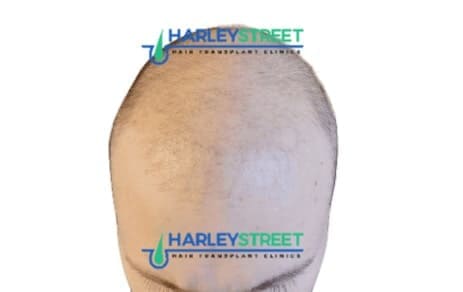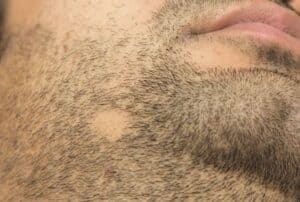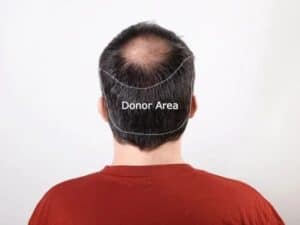Diffuse Hair Thinning: What is it and What Can be Done to Prevent It?
Diffuse hair thinning can be troublesome for anybody suffering from female or male pattern baldness. On this page, you’ll be able to learn about the causes, symptoms, and treatment for diffuse hair loss, as well as differentiate this condition from other hair loss conditions (like telogen effluvium).
Overview
Diffuse hair thinning (sometimes referred to as “diffuse hair loss” or “diffuse alopecia”) is a hair loss condition characterised by widespread and uniform thinning of hair across the scalp rather than specific bald patches.
Unlike patterned hair loss (like male pattern baldness or female pattern baldness), which tends to affect specific areas, diffuse hair thinning affects the entire scalp. The cause of diffuse hair loss is not known, but it is manageable with some treatments.
What is Diffuse Hair Loss?
Diffuse thinning is a hair loss condition affecting almost 50% of adult men and women across the globe (Mounsey et. al, 2009). The condition also affects men and women in equal measures, unlike pattern hair loss conditions (Malkud, 2015).
For patients experiencing diffuse thinning, this can cause a lowering in self-confidence, making many men and women conscious about their appearance.
Patients with diffuse hair loss usually experience universal shedding across the scalp. As more hair follicles are miniaturised across the scalp, this creates an appearance of lower density and thinning.
Diffuse thinning does not occur in any patterned way. In comparison, male pattern baldness, the most common cause of hair loss in men, usually starts to develop as a receding hairline or bald spot at the crown. As stated earlier, diffuse hair loss usually affects the entire scalp, without causing a clear receding hairline or other distinct pattern.
What Causes Diffuse Hair Loss?
Several different factors cause diffuse hair loss. Scientific research has not yet discerned whether diffuse thinning is caused by genetic factors. However, research into environmental causes of diffuse hair loss is definitive. The three main causes of diffuse hair loss include telogen effluvium, hormonal changes, and nutritional deficiencies.
Telogen Effluvium
Telogen effluvium is a hair loss condition where a larger number of hair follicles shift into the “resting” (telogen) phase of the hair growth cycle. This means that more follicles are resting than growing which, in turn, causes hair loss.
Although it’s natural for humans to lose between 50 and 150 hair follicles each day, excessive hair shedding (the shift toward the “catagen” and “telogen” phases), is what causes hair loss.
In patients with diffuse hair loss, telogen effluvium occurs across the entire scalp, causing a more generalised “thinning hair” than concentrated “receding hairline”.
Hormonal Changes
One of the main reasons why men and, in particular, women suffer with hair loss is due to hormonal changes in the body. Changes in hormone levels, specifically that of DHT, have been shown to cause hair loss in male and female patients.
Fluctuations in hormones, such as those that occur during pregnancy, childbirth, menopause, or as a result of thyroid disorders, can lead to diffuse hair loss. So, it’s always important to consider hormonal changes as a reason for excessive hair shedding.
Nutritional Deficiencies
Inadequate nutrition, particularly deficiencies in iron, zinc, biotin, and other essential vitamins and minerals, can contribute to hair thinning. Although nutritional deficiencies may cause temporary hair shedding, it is always important to eat a balanced diet to minimise your chances of diffuse hair loss.
Auto-Immune Medical Conditions
Although rare, some autoimmune medical conditions have been linked to hair loss and, more specifically, diffuse thinning. Diffuse hair shedding has been noted as a symptom for sufferers of some autoimmune conditions.
How Can I Detect Diffuse Thinning?
In its initial stage, diffuse thinning can sometimes be difficult to detect. In most cases, thinning needs time to develop for it to become visible to somebody with the condition or to a friend/family member.
A patient with diffuse hair shedding will notice a gradual thinning of hair across the entire scalp. In more advanced cases, the scalp skin may be visible through the hairline/crown.
It is also important to separate symptoms of diffuse alopecia from androgenetic alopecia. Whilst male pattern baldness will cause a receding hairline and thinning on the crown, this will not occur with patients suffering solely from diffuse alopecia.
If you’re trying to stay vigilant against hair shedding, make sure you keep an eye on your hairbrush, pillow, and plug hole. If you begin to observe an excess of hair follicles in these areas, then it may be wise to consider a hair loss preventative and book a consultation with your GP or a hair transplant surgeon.
Does Diffuse Thinning Permanent or Temporary Hair Loss?
It can sometimes be difficult to tell whether diffuse hair loss is temporary or permanent. If your diffuse thinning is experienced in conjunction with androgenetic alopecia, then it will likely be permanent. Similarly, diffuse thinning due to age is also likely to be permanent.
However, if your diffuse thinning is caused by hormonal or dietary factors, then it may be reversible. With some small lifestyle changes, it is certainly possible to have healthy hair growth again!
If you’re worried about the cause of your diffuse thinning, then don’t hesitate to book a free consultation with our team. We’ll be able to help diagnose your hair loss problem and provide you with a treatment plan moving forward.
What is the Difference Between Diffuse Thinning and Pattern Hair Loss?
There are several differences between diffuse thinning and pattern hair loss conditions. Namely, their respective causes, symptoms, and ways of diagnosing. One common factor between both hair loss conditions are treatable using medications such as minoxidil or finasteride for hair loss.
Whilst the cause of pattern hair loss conditions is usually put down to a genetic predisposition (in which hair loss genes are hereditary), the cause of diffuse hair loss is not as obvious. Scientific research has shown telogen effluvium to be partly responsible for diffuse hair loss, but studies into the genetic causes of diffuse alopecia are still in their infancy.
Diffuse hair loss does not occur in any “patterned” way. Pattern hair loss conditions, like male pattern baldness, will (in almost all cases) begin with a receding hairline, before affecting the crown. In women, female pattern hair loss denotes a familiar pattern where hair follicles thin across the mid-parting.
This means pattern hair loss conditions are traceable using hair loss scales like the “Ludwig” or “Hamilton-Norwood” scale. Because diffuse alopecia does not occur in a patterned way, there is no hair loss scale for this condition.
What is the Difference Between Diffuse Thinning and Alopecia Areata?
Alopecia areata is an autoimmune medical condition For patients suffering from this condition, they will experience concentrated thinning on beard or scalp hair in the size of a 10p/50p piece. In all cases, alopecia areata only causes temporary hair shedding and will, eventually, resolve itself.
As your hair follicles will grow back, no treatment is required for patients looking to combat their alopecia areata. This is the first major difference between alopecia areata and diffuse thinning. For patients with diffuse hair loss, medication or a hair transplant (like the FUE method) is usually recommended.
This is due to the fact that diffuse thinning (as with conditions like androgenetic alopecia) can often cause permanent hair loss. It is this factor that prompts sufferers of diffuse thinning to take medical action and makes them eligible for hair regrowth treatments.
In rare cases, alopecia areata can sometimes cause diffuse thinning before bald patches are visible. In situations where alopecia areata causes thinning before concentrated hair loss, this would be categorised as a condition called diffuse alopecia areata.
If you think you may be suffering from diffuse alopecia areata, then you should book yourself in for a consultation with your GP (to diagnose or rule out this autoimmune condition).
What Can be Done to Prevent Diffuse Hair Loss?
Thankfully, there are several treatments you can pursue if you’re looking to combat diffuse thinning. Moreover, there are a range of treatments you can deploy for early, or late stage, diffuse hair shedding.
Many of the treatments for diffuse hair shedding are also used as treatments for male pattern baldness and female pattern hair loss. Whether you think you’re suffering from diffuse alopecia or androgenetic alopecia, all treatments mentioned will work effectively in both instances.
Topical Minoxidil
Topical minoxidil is an effective treatment for patients suffering with early diffuse thinning, diffuse alopecia areata, and/or don’t want to take DHT blocking medications. Minoxidil comes as a topical solution and is usually applied once a day to the scalp hair.
In doing so, minoxidil helps to increase the blood flow around the scalp, making sure plenty of oxygen and nutrients reach the hair follicle root. This can help to prevent diffuse thinning and help maintain hair density across the scalp.
Finasteride and Dutasteride
Certain medications like finasteride and dutasteride for hair loss are incredibly effective at slowing down the progression of conditions like diffuse thinning and male pattern hair loss. These medications are DHT-blockers and prevent testosterone from transforming into dihydrotestosterone (DHT), the molecule responsible for hair loss.
By blocking DHT, finasteride and dutasteride prevent the hair follicles from shedding. This helps to maintain hair density and prolong the anagen phase of the hair growth cycle. DHT blockers are effective treatments for most sufferers of diffuse thinning, especially from early-to-mid-stage cases.
Low-Level Laser Therapy
Clinical research has shown Low-level laser therapy (LLLT) to be highly effective at treating hair loss in its early stages. Sometimes called a “cold laser” treatment, LLLT uses lasers, or light energy, to encourage hair growth.
In conjunction with a treatment like finasteride or minoxidil, LLLT can be an effective treatment against excessive hair shedding and even male pattern baldness.
Hair Transplant
Hair transplantation is the only long-term solution for permanent hair loss conditions like diffuse thinning or androgenetic alopecia (female pattern hair loss/male pattern baldness). A hair transplant looks to take hair follicles from the back and sides of your head (donor area) and implant them into the area where your scalp needs them most!
For diffuse thinning patients, a hair transplant would aim to increase the hair density across the affected area and hide any signs of excessive shedding. Once your surgery has reversed thinning hair, certain medications like finasteride or dutasteride could be taken to prevent further hair loss.
Some Concluding Remarks
Diffuse thinning, or “diffuse alopecia”, is a common form of hair loss that affects many men and women across the UK. With both genetic and environmental causes, it can be a difficult condition to manage.
For those who experience diffuse thinning, many patients tend to get a full blood count test form their GP and book a free consultation with a hair transplant consultant to assess their options.
Although distressing, there are several treatments for diffuse thinning. Most patients tend to opt for an oral treatment (like finasteride or dutasteride), before opting for a hair transplant. That being said, hair transplants provide the only reversible, long-term solution for diffuse thinning.








